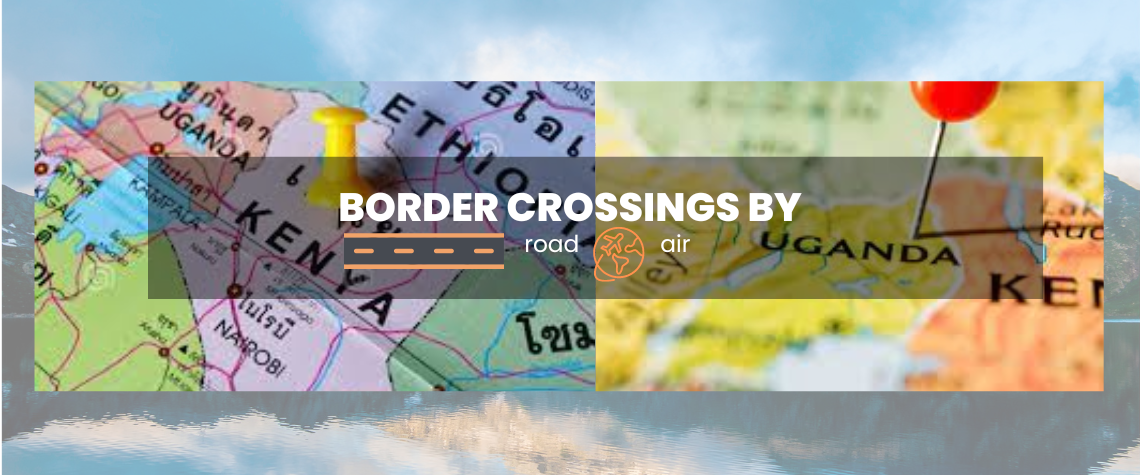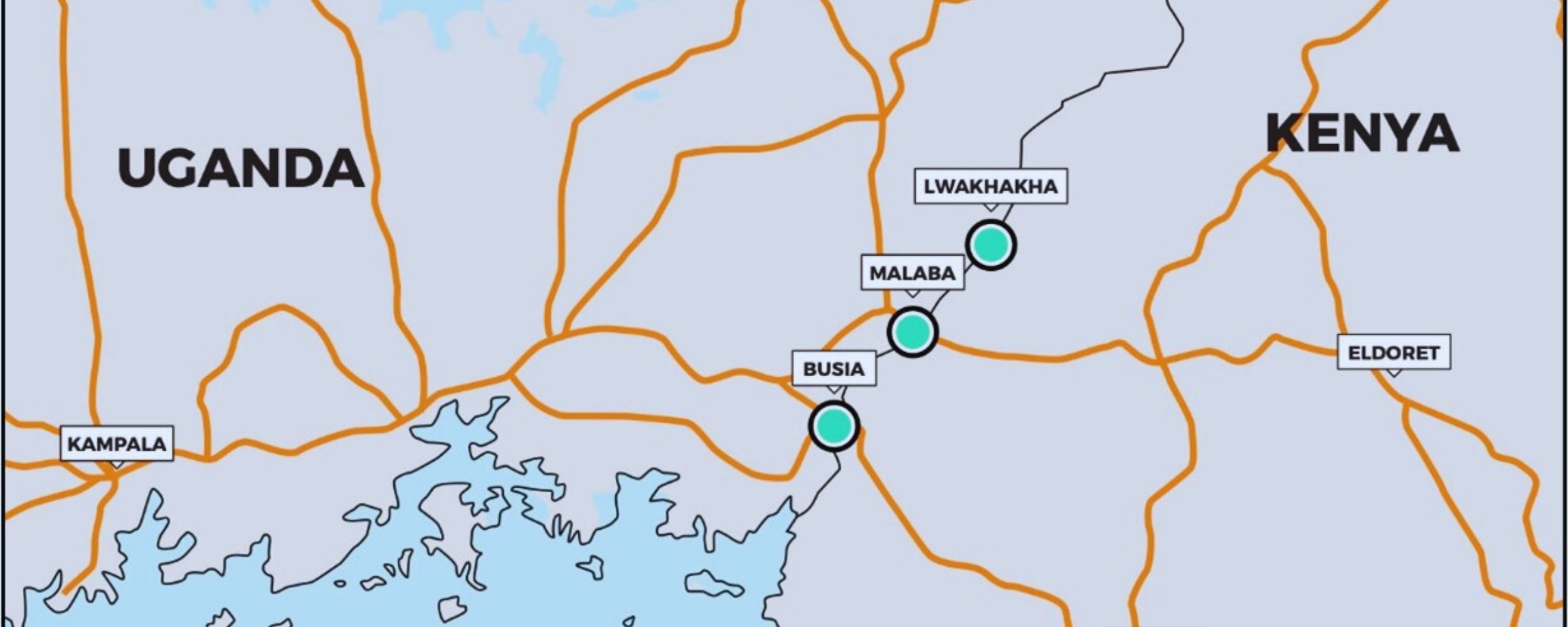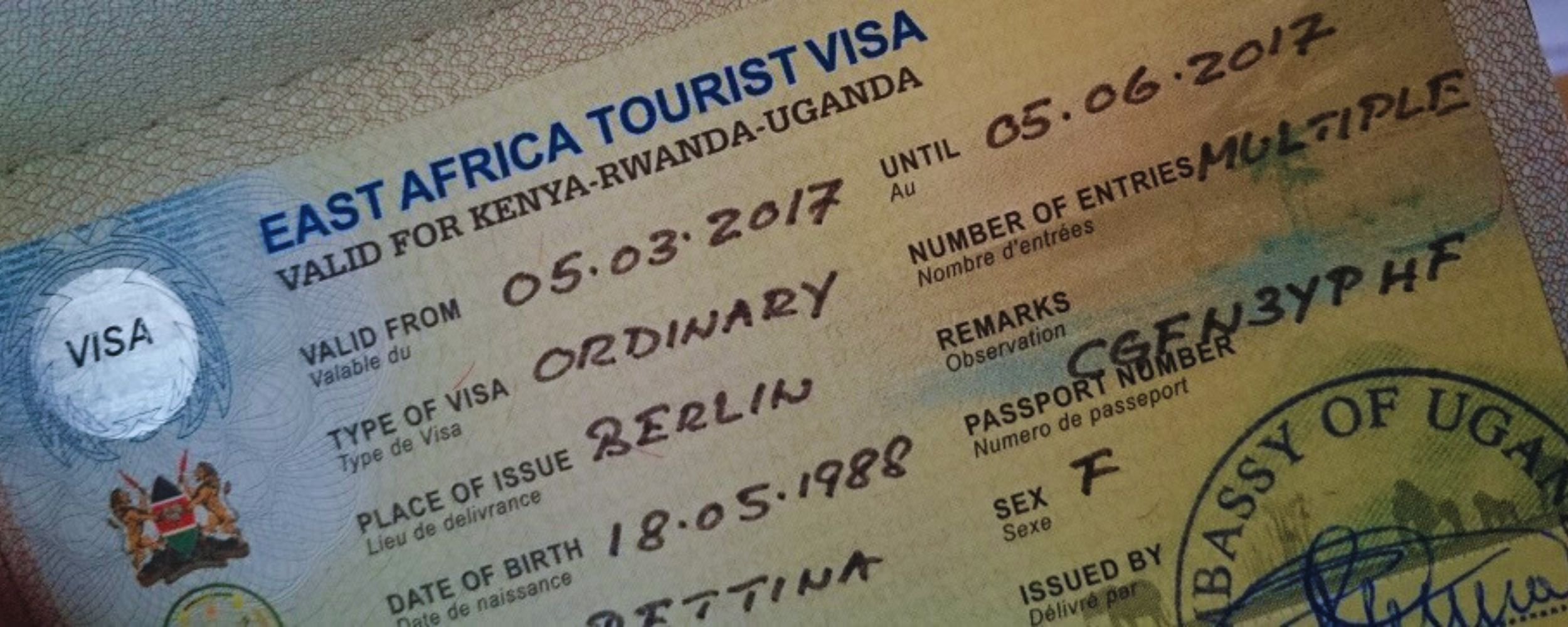
Travelers wishing to go from Uganda to Kenya or vice versa have two options: air or land travel. They can cross the border at a designated checkpoint for either option. The Kenya-Uganda border is frequented by many people, including citizens of both countries and backpackers touring Africa.
Various crossing points are available for land-based travelers to cross between the two East African states. However, not all of these points can be used with a Kenya eVisa.
If you plan to travel by land and cross the border between Kenya and Uganda, this guide provides all the essential information you need.
Crossing Points: Kenya-Uganda Border Posts
There are five official border points along the Kenya-Uganda border that allow travelers to cross from one country to the other.
- Busia
- Lokitanyala
- Lwakhakha
- Malaba
- Suam
Each crossing has its own unique features, such as differing operating hours, visa requirements, and customs regulations. It is important for travelers to be aware of these differences and plan accordingly to ensure a smooth and hassle-free border crossing experience.
Except for Lokitanyala, all of the towns along the Kenya-Uganda border are located in the southern half of the frontier, as seen on a map.
The major border crossings are located at Busia and Malaba, which are situated on the main roads connecting the two countries. Additionally, a train crossing operated by Rift Valley Railways is available at Malaba.
Both Busia and Malaba crossings are fully equipped to handle large numbers of travelers and process digital documents. They are the only land border posts between Kenya and Uganda that are capable of doing so, and are the only authorized crossing points where a Kenya eVisa is accepted.
How is the border between Uganda and Kenya?
The border between Uganda and Kenya spans an impressive distance of 772 kilometers, featuring a total of five crossing points. Three of these points are located in small towns that primarily serve the needs of locals who cross the border for work or to visit family.
In contrast, the remaining two crossing points are situated in the relatively large towns of Busia and Malaba. These two points are crucial gateways for the transportation of goods and people, and as such, thousands of trucks traverse these towns every day, stopping at the border for customs clearance.
In addition to the heavy cargo transportation, various bus routes also pass through these towns, providing convenient transportation options for passengers traveling across the border.
Kenya-Uganda border crossing at Busia

The Busia border crossing stands out as the primary land checkpoint for goods and travelers who traverse between Kenya and Uganda.
Over the past few years, the facilities have undergone significant upgrades, transforming it into a one-stop border crossing that links Busia, Kenya, and Busia, Uganda.
Located in Busia County, Kenya, the town of Busia is strategically positioned along the direct route connecting Kampala and Nairobi via Kimisu. Many travelers prefer to take a direct bus between the two capital cities, which typically takes around 12 to 13 hours. Some bus companies even include a complimentary meal in the price of the journey, making it a comfortable and convenient travel option.
Malaba Kenya-Uganda border point
The border town of Malaba, situated between Tororo, Uganda to the east and Busia, Kenya to the south, ranks as the second busiest crossing point between Kenya and Uganda. This checkpoint is especially convenient for those traveling from Uganda to Eldoret.
Spanning approximately 1 kilometer, the border area boasts a significant width between the Kenyan and Ugandan border posts. Travelers can traverse this distance on foot or by boda-boda, a type of bicycle taxi commonly used in East Africa.
Several regular bus services operate from Kampala, offering direct travel to Eldoret through the Malaba border crossing. Additionally, matatus, or minibuses, provide transportation options from Malaba to Nairobi in Kenya and to Kampala in Uganda.
Guide on Crossing the Border from Uganda to Kenya
Traversing the land border from Uganda to Kenya is a relatively straightforward process, as long as you possess the correct documentation and permission to enter the country.
You can opt to cross the border by driving your vehicle or by taking one of the numerous bus services that run between the two nations.
Upon reaching the border, all bus passengers must disembark and cross the border on foot or via boda-boda while officials inspect the bus.
Border control officers will request to see your passport and visa, along with other pertinent travel documents, to verify your eligibility to cross into Kenya.
Border Crossing Availability on Sundays: Is the Kenya-Uganda Border Open?
Crossing the border between Kenya and Uganda is possible through the checkpoints located in Busia and Malaba, which operate 24/7 under normal circumstances. However, during emergencies and crises like the COVID-19 pandemic that occurred between 2019 and 2021, the border may be closed periodically.
Therefore, it is essential to confirm the border's status before planning a trip during such uncertain times. It is advisable to check when the Kenya-Uganda border is scheduled to reopen to avoid inconvenience.
In summary, while Busia and Malaba border crossing points are open around the clock, travelers must stay informed about border closures during emergencies and plan accordingly.
Required Documentation for Entry at Kenyan-Ugandan Ports

When crossing the border between Kenya and Uganda, there are several documents that travelers are required to present at the ports of entry. These documents are necessary for identification, verification, and record-keeping purposes. Here are some of the essential documents needed when entering Uganda or Kenya:
- Passport: A valid passport is mandatory for entry into both Kenya and Uganda. It must have at least six months' validity from the date of entry and enough blank pages for immigration stamps.
- Visa: Visitors from most countries require a visa to enter Uganda or Kenya. Depending on the purpose and duration of the trip, a single or multiple-entry visa may be necessary. It's advisable to obtain a visa in advance to avoid complications at the border.
- Yellow fever vaccination certificate: Travelers entering Uganda or Kenya from a yellow fever-endemic area must have a valid yellow fever vaccination certificate. This requirement is mandatory, and failure to produce a valid certificate may result in denial of entry.
Visitors from overseas who meet the requirements for a Kenyan eVisa can opt for the convenient online application process, saving them from the hassle of visiting an embassy in person. This option is particularly beneficial for those who do not have an embassy in their country of residence.
For nationals of East African Community (EAC) member states, there is no need for a visa to enter Kenya or Uganda. Additionally, they have the option to use their national ID card instead of a passport for entry into either country. This makes traveling between Kenya and Uganda more accessible and more convenient for EAC nationals. It's worth noting, however, that some other nationalities may also be exempt from kenya visa requirements or eligible for visa-on-arrival. It's essential to confirm visa requirements before traveling to avoid any inconvenience at the border.
The EAC countries are:
- Burundi
- Kenya
- Rwanda
- South Sudan
- Tanzania
- Uganda
Prior to visiting Kenya, travelers should confirm the necessary vaccinations required for entry into the country and ensure that they are up-to-date with their immunizations. This is particularly important as some vaccines take time to become effective and may require multiple doses.
Some of the vaccinations recommended for travelers to Kenya include hepatitis A and B, typhoid fever, yellow fever, and rabies. Malaria is also prevalent in many parts of Kenya, and travelers are advised to take preventive medication and use insect repellents to avoid mosquito bites.
Tips and Recommendations for Crossing the Kenya-Uganda Border
Buses are a convenient mode of transportation for traveling between Kampala and Nairobi, and they offer a comfortable option, especially if you book a VIP seat. The cost of a bus ticket can vary between 2300 to 3400 Kenyan shillings, which is roughly USD $20-30.
To avoid any issues when crossing the border, travelers should double-check that they have all the necessary documentation, such as a valid passport, visa, and yellow fever vaccination certificate. Without these documents, they may be denied entry at the border.
It's also important to ensure that you have the necessary visas for any other countries you plan to visit. A visa for Kenya may not cover entry to Tanzania or other neighboring countries, for example.
When crossing the border, it's advisable to keep all your valuable belongings on your person and not to leave them on the bus. This is to avoid any loss or theft of your belongings during the border crossing process.
It's also recommended to allow enough time for the crossing, as the process can sometimes take longer than expected, especially during peak travel times. By following these tips, travelers can have a smooth and hassle-free experience crossing the Kenya-Uganda border.
Like
Dislike
Get eTA to Kenya
- Step1: Apply on-line Provide the information from your passport to eTA application.
- Step2: Make an online payment Payment Methods: Credit Card
- Step3: Check your e-mail address If your payment is confirmed, your eTA will be sent to your e-mail
Recent News
- Yellow Fever and Yellow Fever Vaccination Guide
- List of states and territories exempted from quarantine in Kenya, corona passport
- Kenya Covid-19 Information
- Kenya Health Care and Vaccination Information
- Embassy Travel Service Registration For the US and Canadian Citizens
- Kenya Travel Static
- Can you Enter Kenya Port of Entry with e-Visa?
- Climbing Mount Kenya Information
- Kenya Visas on Arrival
- Kenyan Visa Invitation Letter for all Types of Visit
- Kenya Starts Offering Hiking Holidays
- Understanding Kenya's Customs Regulations: A Comprehensive Guide
- Kenya-Uganda Border Crossings
- Kenya e Visa Requirements for Children
- Kenya East African Tourist Visa
- Do I need to apply for a Kenya visa for my children
- Is it safe to travel to Kenya
- License agreement to be passed through Kenya Tourism Board KTB for tour visas
- Samburu National Park a reservoir of wildlife in Kenya
- New tourism campaign in Kenya to attract more tourists
- Direct flights from the US to Kenya to boost tourism
- New Kenyan Visa policy Visa free travel for South Sudanese citizens
- Is Kenya safe for solo female travelers
- Kenya Announces Visa Waiver for Vaccinated Tourists
- Kenya Launches New Online Visa System to Ease Application Process
- E-visa Made Easy: A Step-by-Step Guide to Obtaining an Electronic Visa for Kenya
- Exploring Nairobi: The Vibrant Capital of Kenya
- The Best Beaches in Kenya - Top 10
- Top 10 Restaurants In Kenya
- Hidden Gems: Exciting Activities to Discover in Nairobi, Kenya!
- Exploring Kenya Top Tourist Destinations and Must-See Attractions
- Discover the Ideal Time for an Unforgettable Experience in Kenya
- Exploring Culinary Delights: Indulge in the Vibrant Food and Beverage Culture of Kenya
- Guide to Getting Around Kenya
- Shopping tips for Kenya
- Essential Tips For Your First Trip to Kenya
- Important Considerations For Camping With Large Groups
- Kenya Travel Guides All You Need to Know
- Top 10 must-do and must-see experiences in Turkana County
- 5 Best Bus Services to Western Kenya
- Exploring Kitui County: 15 Must-See Attractions and Activities
- Discover Kenya: 20 Unique Accommodation Experiences
- Traveling in Comfort: Kenya Best Matatus and Long-Distance Buses
- Discover Africa: The 5 Must-See Tourist Spots
- Check Your Kenya Visa Status Online
- Kenyan Visa for Ireland
- Kenyan Visa for Turkey
- Kenyan Visa for Brazil
- Kenyan Visa for Russia
- Which Countries Can Enter Kenya without Visa?
- Apply Kenya eVisa for Medical Treatment
- Kenya Visa for Portugal
- Kenya Visa for Thailand
- Kenya Visa for Argentina
- Kenya Visa for Greece
- Kenya Visa for Israel
- Kenya Visa for Egypt
- Kenya Visa for Mexico
- Kenya Visa for Albania
- Kenya Visa for China
- Kenya Visa for Austria
- Kenya Visa for Finland
- Kenya Visa for New Zealand
- Kenya Visa for Saudi Arabia
- Kenya Visa for Indonesia
- Kenya Visa for United Arab Emirates
- Kenya Visa for Chile
- Kenya Visa for Czechia
- Kenya Visa for Qatar
- Kenya Visa for Kuwait
- Kenya Visa for Hungary
- Kenya Visa for Colombia
- Kenya Visa for Taiwan
- Kenya Visa for Romania
- Kenya Visa for Bulgaria
- Kenya Visa for Peru
- Kenya e-Visa for Ukraine
- Kenya Visa for Philippines
- Kenya Visa for Vietnam
- Kenya e-Visa for Hong Kong
- Kenya Visa for Bangladesh
- Kenya Visa for Algeria
- Kenya Visa for Morocco
- Perfect Packing List for your Kenya Vacation
- Kenyan Food 20 Must-Try Dishes in Kenya
- Journey to Nanyuki Riding the Rails to Serene Splendor
- Journey with Ease Kenya Railways SGR Train Online Booking Platform
- 5 ways to enjoy your vacation on kenya
- 10 essential things to pack
- A Serene Coastal Escape Exploring the Beauty of Watamu
- List of national parks in kenya
- Best cities to visit in Kenya
- Exploring the Gems of Kenya Your Ultimate Travel Guide to the Land of Safari and Diversity
- Unveiling Hidden Gems The Ultimate Guide to the Best Places to Explore
- Ascending the Heights Conquering Mount Longonot Beginner Trail
- Roaming the Wild A Spectacular Safari Itinerary
- Kenyan Coast - Top 10 best beaches in kenya
- Best things to do and see in Kenya
- Discover Kenya Top 10 Breathtaking Beaches
- Kenya Positioned to Embrace the Role of Africas Singapore
- What Vaccines Should I Get Before Traveling to Kenya?
- Yellow Fever Certificate: Guidelines and Requirements for Traveling to Kenya
- Kenya Travel Advice
- 10 Photogenic Spots in Kenya
- What Currency Mobile Money Is Used In Kenya
- Processing Time for a Kenya Visa Application
- Weather in Kenya
- What Languages Are Spoken In Kenya
- Top things to remember before visiting Kenya
- Kenya summary tables on languages religions economy land use and transport
- Significant Challenges Affecting Tourists in Kenya
- Top 20 destinations in Kenya
- Best Tourist SIM Cards for Calling and Data in Kenya
- Kenya Partner with Uganda to Boost Tourism
- Africa Eyes Visa-Free Travel and Memorial Parks for Tourism Growth
- Defining Travel Trends in 2023
- Kenya and Djibouti Visa-Free Travel for Trade
- Life as a Digital Nomad in Kenya
- 20 Reasons Why Nairobi Excels the Ultimate Hub for Digital Nomads in Africa
- Why Kenya is a great place for digital nomads
- Domestic Tourism in Kenya
- Kenya 2023 Tourism 7 Parks Dominate 80pc Visitors
- Kenya Visa Types
- Kenya-DRC Removes Visa Requirements
- Kenya Comoros Visa Deal
- Kenya Travel Updates
- Kenya Visa on Arrival Suspended
- Kenya Decision on Visa Restrictions
- Kenya Top Travel Destinations
- Kenya Suspends E-Visa After Cyberattack
- Belgium Visa in Kenya
- Kenya and Uganda Partner to Boost Tourism
- Passport 6-Month Validity Rule for Kenya eTA
- Kenya Tourism Earnings Surge 31pc to 1B in 6 Months
- UNWTO Secretary General Awards Kenya Olergesailie Best Tourism Village
- Kenya and Tanzania Commended for Waiving Visas for Congolese Citizens
- 2023 Travel Updates on Kenya Evolving Travel Restrictions and Guidelines
- Updates on the Kenya Visa on Arrival
- Kenyan eCitizen Portal Outage Halts eVisas
- Direct Flights to Nairobi From India
- Visa-free entry of Indonesia citizens to Kenya
- Kenya Visa Requirements Rules Updates
- Kenya eTA Issues And How To Solve Them
- Best Things to do in Kenya
- Common causes for Kenya eTA rejections
- Kenya work and residency permits
- Major Kenyan Cultural Festivals
- Favourable Periods to Visit Kenya
- Kenya to become visa-free to African visitors
- TCS as a Game-Changer in Travel Innovation
- Turkey Visa for Kenya Citizens
- Turkish visa for Kenyan citizens
- Africa Travel Opportunity Rising Middle Class
- List of African countries every African can visit without a visa
- Kenya Announces Visa-Free Travel for All Starting January 2024
- Kenya Visa-Free Boon or Bust
- 10 Top Food to Try in Kenya
- Kenya Explore Visa-Free Paradise in Africa Heart
- Top Places to Visit in Kenya
- Things to Do in Kenya - Beautiful and Magical Country
- All About Kenya Visa
- Kenya Visa-Free Countries-Passport Travel
- Kenyan Travel Planner for First-Timers
- Kenya Culture: A Beginner's Guide
- Top Cities and Towns to Visit in Kenya for Tourists and Travellers
- Kenya Travel Tips for Women Travellers
- Top 10 Attractions and Activities for Visitors in Turkana County, Kenya
- Kenya Travel Inspiration
- Top 50 Attractions and Activities For Visitors in Nairobi, Kenya
- Travellers Safety in Kenya
- Practising Responsible Tourism During the COVID-19 Pandemic
- Top most places to visit in Kenya
- Top 5 Essential Items for Backpacking in Kenya
- Top Travel Movies That Spark Wanderlust and Adventure
- Kenya backpacking itinerary guide
- The Kenya Tourism Panel
- Top Visa-Free African Destinations for Kenyan Travelers and Backpackers
- Kenya's Current Population: An Overview
- Flight Duration to Kenya: How Long Does it Take to Fly?
- Essential Travel Advice and Smartphone Apps for Avid Backpackers
- Currency Utilized in Kenya
- Important Tips for Travelers and Backpackers Navigating the World Alone
- Transforming Connections: Kilifi's Backpacker Hostel for Distant Relatives
- Renowned Aspects of Kenya
- Top Things to Note and Do Before Travelling Out of Kenya
- Required Vaccinations for Traveling to Kenya
- Backpacking Destinations in Jinja, Uganda for Kenyans
- What is the current time in Kenya?
- Which species of animals can be found in Kenya?
- Kigali, Rwanda Backpacking
- At what point in time did Kenya achieve its independence?
- What is the time in Kenya
- Guide about Kampala, Uganda Backpacking
- Covid 19 Travel Information For Kenya
- Road trip guide Traveling from Kenya to Kigali Rwanda by Road
- Doing Business with Kenya
- Top Shuttle Services from Nairobi to Arusha and Moshi
- Explore These 9 Unmissable National Parks in Kenya
- Affordable Bus Fare Options in Africa
- Explore the beauty of Africas heartland
- Backpacking Guide Essential Resources for Exploring Kenya
- Journeyed Overland and Rails: From Nairobi, Kenya, to the Majestic Victoria Falls in Zambia and Zimbabwe
- Budget stays Comparison of Airbnb, Couchsurfing and Hostels
- Adventure Guide: Road Trip from Nairobi to Victoria Falls
- Adventurous Journey: Riding a Motorcycle from Nairobi to Arusha, Tanzania
- 50 Must-Experience Destinations and Activities in Nairobi
- Budget-Friendly Backpacker Accommodations in Kenya
- Exploring Elephant Hill: Trekking Adventure in the Aberdare Ranges
- Online Booking Platform for Kenya Railways SGR Train
- Railway Journeys: Exploring the TAZARA Route from Dar es Salaam to Kapiri Mposhi
- Nairobi, Kenya to Victoria Falls (Zambia/Zimbabwe) by road and rail
- 15 Breathtaking Eco Lodges in Kenya 2023 Edition
- Exploring Volunteering Opportunities in Kenya: An In-Depth Insider's Guide
- Streamlined Booking for the Madaraka Express Train: Secure Your Advance SGR Reservations Now!
- Bus Routes: Nairobi to Harare and Burundi
- Exploring Kenya on a Backpacker's Trail: Your Ultimate 2023 Travel Guide
- Bus Travel in East Africa
- Exploring Nyeri Countys Top 8 Must-See Destinations in a Single Day
- Overland Journey from Nairobi to Johannesburg: Traveling by Road
- Kenya's New Visa Hack: Say "Hakuna Matata" to Visa Woes with the E-Thrill Pass!
- Foreigners still apply for Kenyan Visa Despite President's Announcement
- How to Get Your Kenya Electronic Travel Authorisation (eTA)
- Kenya's ETA System: Progress or Burden for Travellers?
- Frequently Asked Questions
- Kenya waives visas with conditional stipulation
- EAC Kenyan entry causes confusion on specifications
- Kenyan Passport Soars 6 Places in 2024 Henley & Partners Ranking
- Kenya Drops eTA Fee for South Africa, Ethiopia & More!
- Nairobi Outshines Paris as Top Travel Destination.
- Kenya Initiates Visa-Free Policy at a Processing Fee Requirement
- Kenya eTA Streamlines Entry Starting 2024
- Visa-Free Kenya Unravel Africas Secrets One Step at a Time
- FAQS on Kenya Electronic Travel Authorization
- Amount needed to acquire the Kenya eTA
Other Info
- Kenya eTA
- eVisa eTA Online
- Kenya Online eTA
- Kenya eTA
- Kenya Entry Requirements
- Kenya eTA Requirements for US Citizens
- Kenya eTA for US Citizens
- Vaccines For Kenya
- Yellow Fever Vaccine Kenya
- Yellow Fever Certificate Kenya
- Vaccinations Required For Kenya
- Kenya Transit eTA
- Kenya Multiple Entry Visa
- Kenya Business eTA
- Kenya eTA Fees
- Kenya eTA Cost
- Kenya eTA Application
- Kenya Online eTA Application
- Kenya eTA Processing Time
- Kenya eTA on Arrival
- Turkey Visas for Tourism, Business Purposes
- Apply for Turkish Student Visa
- Turkey Work Visa or Work Permit
- Turkey Transit Visa
- Turkey Residence Permit
- Turkish Visa
- E Visa of Turkey
- Visa for Turkey US Citizen
- Turkey Visa for Pakistani
- Electronic Visa Turkey
- Turkey Travel Visa
- Visa on Arrival Turkey
- US Citizen Travel to Turkey
- Chinese Embassy Turkey
- Visa for Turkey From Canada
- Visa Required for Turkey
- Visa Transit Turkey
- Turkey Transit Visa for US Citizens
- Form for Entry to Turkey
- Turkey Visa for US
- Visa Requirements for Turkish Citizens
- Need Urgent Turkey Visa?
- Turkey Visa Information
- Turkey Essential Guidelines for U.S. Citizens
- US Visa for Turkey
- Passport for Turkey
- Turkey Visa Online
- Turkey Visa for Indian
- Turkish Visit Visa
- Visa Application Form Turkey
- E Visa Turkey Cost
- Tourist Visa to Turkey
- Visa Application to Turkey
- Apply Visa to Turkey
- Traveling to Turkey From Canada
- Getting a Visa for Turkey
- Visa Cost Turkey
- See More

3
Comment